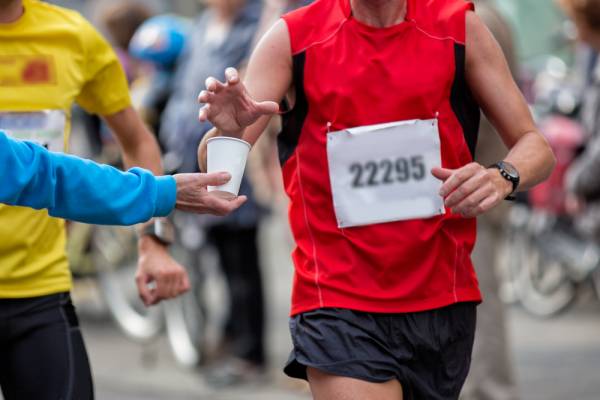Proper hydration is critical for endurance athletes. Unfortunately, actually meeting that goal is not so easy. As reported in the April 2015 issue of the Journal of Strength and Conditioning Research, thirst is not a reliable guide to hydration, but neither is time expended, exercise rate, or any of a number of other parameters.1 Sweat rates can also vary between individuals and from one event to the next, so there is no single strategy or rule of thumb that will work for all athletes.
So, what’s an athlete to do? Based on what they learned, the authors of this April 2015 study suggested an easy approach to developing individual hydration plans.
The Dehydration Dilemma
Dehydration can cause significant performance degradation. In other research, loss of only 1-1.8% of body weight caused sharp performance declines.2 Worse, dehydration can lead to heat exhaustion and potentially life-threatening complications. The National Athletic Trainers’ Association recommends ensuring that weight loss does not exceed 2% over the course of an event.
“Replenishing water without adding salt and other electrolytes can be as dangerous as dehydration.”
For a long time, therefore, endurance athletes were told to drink as frequently as possible. Marathoners, for example, were advised to stop at every available water station. Unfortunately, replenishing water without adding salt and other electrolytes can be as dangerous as dehydration. The body’s fluids can become too dilute, a condition known as exertional hyponatremia. It, too, can have life-threatening consequences.
So what’s an athlete to do? Is there a general rule? “Drink x amount of water per ten miles?” “Per hour?” “Per ten pounds of body weight?”
No, there is not.
Monitoring Water Balance in Endurance Cycling
In this new study, researchers recruited 26 participants in the Wichita Falls, Texas Hotter’n Hell Hundred, a hundred-mile cycling event held in August. Temperatures on race day routinely exceed 100 degrees Fahrenheit. At the particular event being studied, the race day high, low, and mean temperatures were 108, 78, and 96 degrees, respectively. Humidity ranged from 58% just after the start, down to 17% in the afternoon, with a mean of 29%.

Participants were weighed before and after the race, as well as at multiple aid stations for riders who stopped. (Eight of the study participants completed the race without stopping.) Water and food consumption were monitored, as were perceived thirst, urine color, urine volume, and other parameters. The participants were all experienced endurance cyclists, and were told to follow their usual eating and drinking routines.
“Thirst is not reliable, but neither are estimates based on the athlete’s weight or fitness, or on the event distance and terrain.”
By monitoring both food and water intake, the researchers were able to calculate both weight loss and water balance. Solid food increases weight but adds little water, so measuring weight loss alone generally underestimates water loss. Over the duration of the event, participants lost 2.7% of body mass on average, or about 3.4 quarts of water over the duration of the event. Thus, most participants experienced dehydration in excess of National Athletic Trainers’ Association guidelines, sufficient to undermine performance.
Thirst Is a Lie, and So Is Everything Else
There were few correlations among the variables considered. Thirst did not predict either fluid intake or body mass change. While fluid intake did correlate with sweat loss, athletes who drank more fluids were no more successful in maintaining their overall water balance. Physical characteristics like weight and body mass index were not predictive, nor was time spent on the course. Contrary to conventional wisdom, neither larger nor slower cyclists consumed more water or experienced more severe dehydration.
“Researchers concluded that sweat-loss rate is extremely individual, and no helpful generalizations are possible.”
Instead, the researchers concluded that sweat-loss rate is extremely individual, and no helpful generalizations are possible. Rather, they suggested that a simple measurement of approximate sweat-loss rate be used to plan water intake. If the athlete exercises for an hour under near-event conditions, his or her sweat rate can be calculated from the amount of weight lost and used to plan hydration needs for the event itself. Because weight loss is not the same as water balance, this measurement will tend to underestimate sweat rate, helping to ensure the athlete avoids hyponatremia.

Though this method can be applied to any endurance sport, the researchers pointed out that cyclists are unique in their ability to carry water on the bicycle frame. Athletes with less ability to drink as much and as often as they like will need to plan water stops more carefully.
The Individual Approach
To summarize, then, it appears that most common rules of thumb for judging hydration are wrong. Thirst is not reliable, but neither are estimates based on the athlete’s weight or fitness, or on the event distance and terrain.
Instead, the best hydration approach is always going to be individual, based on the athlete’s sweat rate under race conditions.
You’ll Also Enjoy:
- Drinking to Thirst: Is It Enough?
- An Athlete’s Guide to Hydration: When, What, and How Much
- How Long Does It Take to Get Hydrated
- What’s New On Pulse Beat Fit Today
References:
1. Armstrong, L.E., et. al. “Ultraendurance cycling in a hot environment: thirst, fluid consumption, and water balance.” J Strength Cond Res 29(4), 869–876, 2015.
2. Bardis, C.N., et. al. ”Mild dehydration and cycling performance during 5- kilometer hill climbing.” J Athl Train 48, 741–747, 2013.
Photos courtesy of Shutterstock.






